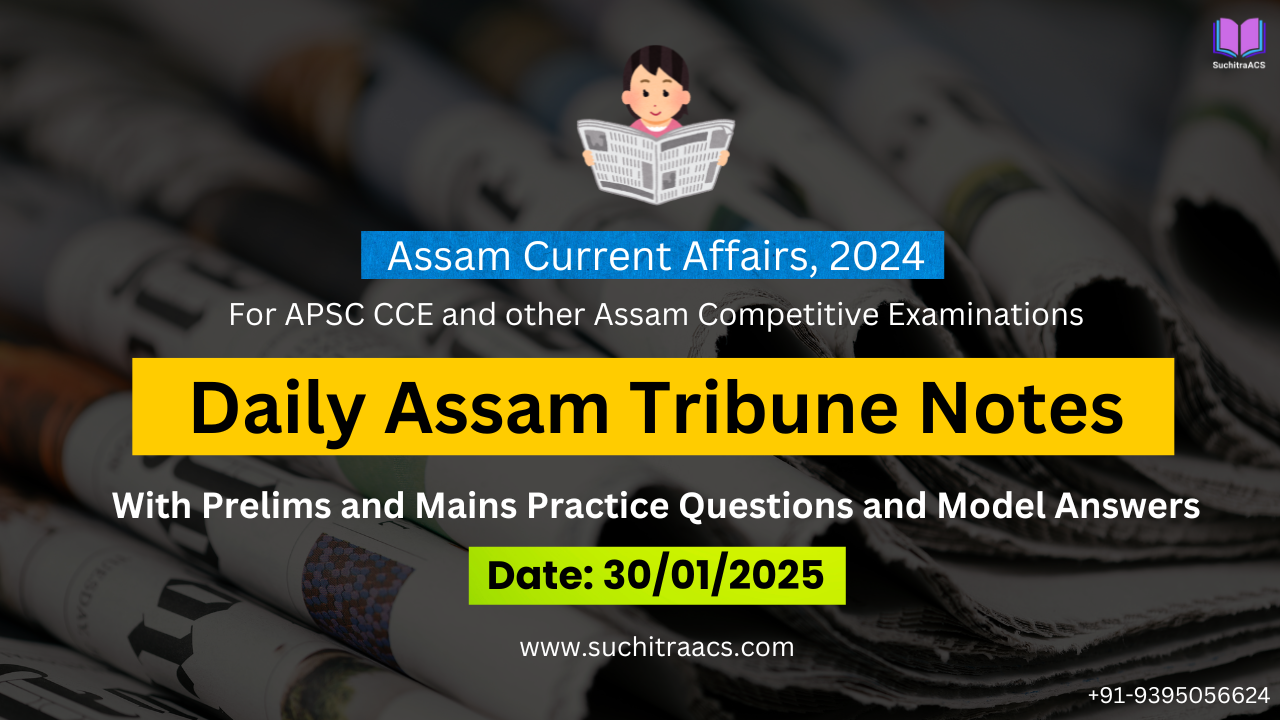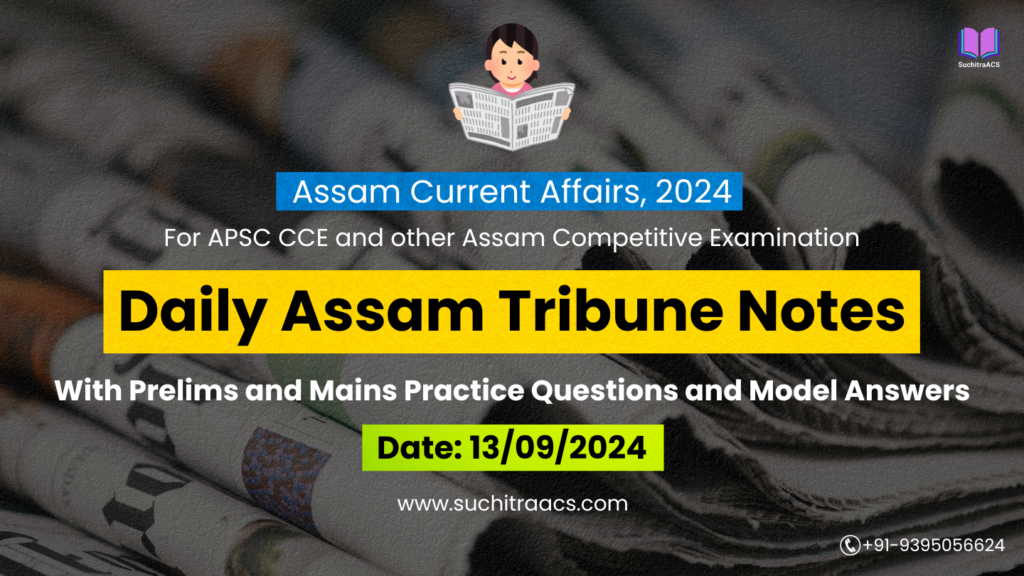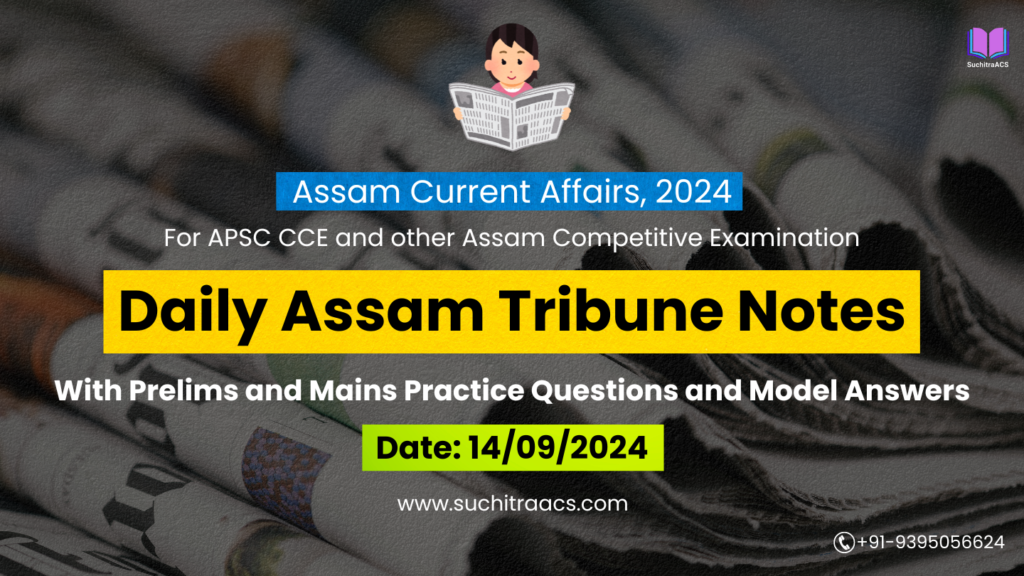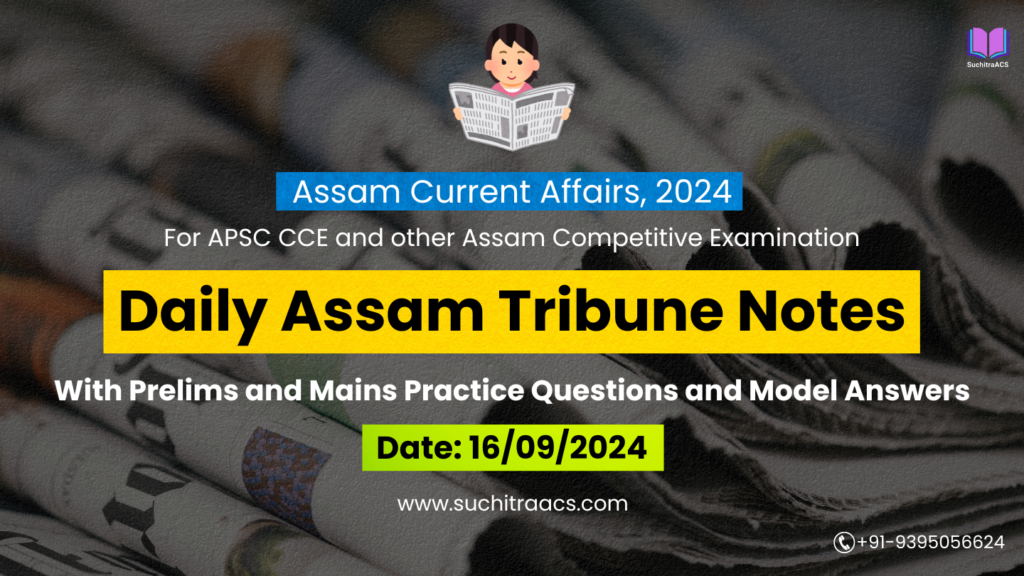APSC Current Affairs: Assam Tribune Notes with MCQs and Answer Writing (30/01/2025)
For APSC CCE and other Assam Competitive examinations aspirants, staying updated with current affairs is vital. This blog covers most important topics from the Assam Tribune today (30-01-2025). These issues are key for both APSC Prelims and Mains preparation, offering insights into the APSC CCE Syllabus.
1. Assam Workforce and Investment Opportunities
Relevance:
- GS Paper 2: Governance, Human Resource Development
- GS Paper 3: Economic Growth, Infrastructure, Industrial Development
Introduction
The Assam government has identified its young workforce as a key advantage for attracting investors. With a median age of 22.7 years, lower than the national average of 26.8 years, the state aims to leverage its skilled human capital, educational institutions, and industrial infrastructure to boost investment in sectors like renewable energy, tourism, and manufacturing.
Key Points
1. Assam’s Workforce and Educational Infrastructure
- Skilled Workforce Availability:
- 20 state universities, 2 central universities, and 9 private universities.
- 49 institutes offering degrees/diplomas in engineering and technology.
- 44 government industrial training institutes (ITIs).
- 13 existing medical colleges with 10 more under development.
- Assam Skill University with a capacity of 10,000 students per annum and 80 courses.
2. Key Investment Opportunities in Assam
- Renewable Energy:
- Assam has an estimated renewable energy potential of 14,487 MW, with 94% of it being solar energy.
- Investment potential in solar power, floating solar projects, and compressed biogas projects.
- Electronics Manufacturing:
- Electronic Manufacturing Cluster (EMC) in Jagiroad to develop Assam’s position in semiconductor and electronics production.
- Tourism and Hospitality:
- Investment potential in hotels, adventure tourism, river cruises, and eco-tourism projects.
- Assam’s unique biodiversity and cultural heritage make it an attractive destination.
Prelims Pointers
- Median Age Concept: The midpoint age where half of the population is younger and the other half is older.
- Electronic Manufacturing Cluster (EMC): A facility to promote electronics production and semiconductor manufacturing.
- Compressed Biogas (CBG): Renewable fuel derived from organic waste, reducing dependency on fossil fuels.
Mains Pointers
Significance of Assam’s Workforce and Investment Potential
- Boost to Industrialization:
- Skilled workforce enables manufacturing and technology-based industries.
- EMC and industrial estates improve Assam’s appeal for FDI and private investment.
- Economic Development & Job Creation:
- Expansion of renewable energy, IT, and tourism sectors will create employment.
- Increased infrastructure spending strengthens the economy.
- Sustainable Growth:
- Focus on clean energy and eco-tourism ensures environmentally responsible development.
- Skill development aligns with future-ready jobs in AI, digital economy, and green energy.
Challenges in Implementation
- Skill-Industry Mismatch:
- Lack of direct industry-academia collaboration results in underutilization of workforce potential.
- Infrastructure Gaps:
- Need for better road connectivity, logistics hubs, and digital infrastructure.
- Investment Bottlenecks:
- Delays in land acquisition, bureaucratic hurdles, and policy uncertainty deter investors.
- Renewable Energy Integration Challenges:
- High initial costs and lack of advanced storage solutions slow down adoption.
Government Initiatives Supporting Workforce & Investment
- Advantage Assam 2.0: State initiative to attract foreign investment.
- North East Industrial Development Scheme (NEIDS 2017): Incentives for industries in Assam.
- PM Kaushal Vikas Yojana (PMKVY): Enhancing skill development programs.
- Assam Industrial Policy 2019: Subsidies and tax benefits for investors.
Way Forward
- Industry-Academia Collaboration: Strengthen tie-ups between universities and industries to bridge the skill gap.
- Policy Simplification: Reduce bureaucratic delays and implement single-window clearances for businesses.
- Investment in Infrastructure: Improve power supply, logistics, and connectivity to attract large-scale industries.
- Technology-Driven Growth: Promote AI, robotics, and smart manufacturing in key sectors.
Conclusion
Assam’s young workforce, combined with strategic industrial and renewable energy investments, can transform the state into an economic hub. By addressing skill gaps, infrastructure issues, and investment challenges, Assam can emerge as a leader in sustainable economic development in the Northeast.
2. PMJAY–Ayushman Bharat Pending Reimbursements and Healthcare Crisis
Relevance:
- GS Paper 2: Health, Governance, Welfare Schemes
- GS Paper 3: Economy, Financial Inclusion, Public Service Delivery
Introduction
The Ayushman Bharat–Pradhan Mantri Jan Arogya Yojana (PMJAY) aims to provide cashless health insurance to economically vulnerable populations. However, in Assam, pending reimbursements of around ₹750 crore to private and public hospitals have triggered a liquidity crisis, affecting healthcare delivery and hospital operations.
Key Points
1. Status of PMJAY in Assam
- 1.72 crore Ayushman cards issued in Assam.
- 366 empanelled hospitals (183 public + 183 private).
- Since August 2024, only 303 procedures are covered under PMJAY in private hospitals, leading to increased pressure on public healthcare facilities.
2. Financial Challenges & Liquidity Crunch
- Delayed payments of ₹750 crore since April 2024.
- Private hospitals struggling to pay staff salaries, vendor dues, and statutory payments.
- Government’s slow response has led to operational difficulties, risking patient care.
3. Broader National Concerns
- Similar issues reported in Haryana (₹400 crore pending), with threats of PMJAY suspension by hospitals.
- Punjab & Haryana High Court previously attached salaries of officials for failing to release payments.
Prelims Pointers
- PMJAY-Ayushman Bharat: India’s largest health insurance scheme covering ₹5 lakh per family per year.
- Empanelled Hospitals: Healthcare institutions eligible to provide treatment under PMJAY.
- Liquidity Crisis: A situation where hospitals lack cash flow to meet expenses despite pending reimbursements.
Mains Pointers
Significance of PMJAY & Its Challenges
- Strengthening Healthcare Access:
- Provides free treatment to 50 crore Indians from low-income groups.
- Reduces out-of-pocket expenditure, ensuring financial protection.
- Economic & Institutional Impact:
- Liquidity crunch threatens hospital operations, affecting medical staff payments.
- Delays in payments increase patient waiting times in government hospitals.
- Trust Deficit Among Healthcare Providers:
- Private hospitals are reluctant to accept new PMJAY patients due to non-payment issues.
- In states like Haryana, healthcare providers threaten to withdraw from the scheme.
Challenges in Implementation
- Delayed Reimbursements:
- Bureaucratic inefficiencies slow down claim processing.
- State and central fund allocation mismatch delays payments.
- Policy Changes Without Stakeholder Consultation:
- Restriction of procedures (303 allowed in private hospitals) forces patients into overburdened public hospitals.
- Limited Healthcare Infrastructure:
- Overcrowding in government hospitals increases patient suffering.
- Rural healthcare facilities lack adequate resources.
- Coordination Issues Between Centre & States:
- PMJAY funding requires states to release their share before receiving central funds.
- Assam’s financial delays have slowed overall scheme effectiveness.
Government Initiatives to Improve PMJAY Implementation
- Streamlining Claim Settlements:
- E-payment processing systems to expedite payments.
- Regular audits to ensure timely reimbursement.
- Strengthening Public-Private Partnership:
- Encourage more private hospitals to join PMJAY.
- Assure timely payments to prevent service withdrawal threats.
- Expansion of Healthcare Services:
- Improve infrastructure in government hospitals to reduce pressure on private hospitals.
- Increase budgetary allocations for healthcare.
- Transparent Fund Disbursement Mechanisms:
- Implement real-time tracking of pending claims.
- Establish State-Level Health Monitoring Committees for fund management.
Way Forward
- Ensure Timely Fund Releases: Improve coordination between state and central governments to clear backlogs.
- Expand Private Hospital Participation: Address payment delays to retain private hospitals under PMJAY.
- Strengthen Healthcare Infrastructure: Invest in district-level hospitals to reduce the dependency on empanelled private hospitals.
- Regular Audit & Accountability: Implement digital tracking systems for claim processing.
Conclusion
PMJAY has transformed India’s healthcare landscape, but financial bottlenecks threaten its sustainability. Assam’s ₹750 crore backlog highlights the need for efficient fund disbursement and stronger governance to ensure healthcare delivery remains uninterrupted.
3. ISRO’s 100th Space Mission Milestone
Relevance:
- GS Paper 3: Science & Technology, Space Technology, Achievements of Indian Scientists
Introduction
The Indian Space Research Organisation (ISRO) has reached a historic milestone by successfully launching its 100th space mission. The mission involved launching a navigation satellite using the GSLV-F15 rocket from Satish Dhawan Space Centre, Sriharikota. This achievement showcases India’s growing capabilities in space technology, highlighting its commitment to precision agriculture, navigation, and maritime applications.
Key Points
1. ISRO’s 100th Mission Highlights
- The 100th mission involved the launch of a navigation satellite using GSLV-F15.
- The satellite aims to support terrestrial, aerial, and maritime navigation, and precision agriculture.
- ISRO’s launch count over the years:
- PSLV: 62 missions (most reliable rocket).
- GSLV: 17 missions (uses indigenous cryogenic upper stage).
- LVM3 (GSLV MkIII): 7 missions (used for Chandrayaan-3).
- SSLV: 3 missions (Small Satellite Launch Vehicle).
2. Historical Evolution of ISRO’s Launch Vehicles
- SLV (1979): India’s first satellite launch vehicle.
- PSLV (1993-Present): The most reliable and versatile launch vehicle.
- GSLV (2001-Present): Introduced cryogenic technology for heavier payloads.
- LVM3 (2014-Present): Used for Chandrayaan-2, Chandrayaan-3, and Gaganyaan.
3. PSLV – ISRO’s Workhorse Rocket
- PSLV has launched several landmark missions, including:
- Chandrayaan-1 (2008): India’s first moon mission.
- Mangalyaan (2013): India’s Mars Orbiter Mission (MOM).
- IRNSS/NavIC satellites: India’s regional navigation system.
Prelims Pointers
- GSLV-F15: Rocket used for the 100th mission.
- PSLV (Polar Satellite Launch Vehicle): ISRO’s most used rocket.
- Cryogenic Upper Stage: Used in GSLV for launching heavier satellites.
- Satish Dhawan Space Centre: India’s primary launch site.
- NavIC (Navigation with Indian Constellation): India’s GPS alternative.
Mains Pointers
Significance of ISRO’s 100th Mission
- Technological Advancements:
- Strengthens India’s space capabilities in precision navigation and surveillance.
- Showcases indigenous cryogenic technology for launching heavy payloads.
- Boost to Strategic Capabilities:
- Enhances defense applications through advanced navigation.
- Improves disaster management and maritime surveillance.
- Economic and Commercial Benefits:
- Expands India’s space economy by attracting international satellite launches.
- Strengthens ISRO’s credibility as a reliable global launch partner.
- Support for Government Initiatives:
- Contributes to Digital India, improving navigation for logistics and transport.
- Aligns with Gati Shakti and Smart Cities Mission for infrastructure planning.
Challenges in India’s Space Program
- Budget Constraints:
- ISRO operates with a relatively smaller budget compared to NASA and SpaceX.
- Private Sector Involvement:
- Lack of private investment in space technology and R&D.
- Global Competition:
- Rising competition from China’s CNSA and SpaceX’s Starlink program.
- Technological Challenges:
- Need for advancements in reusable launch vehicles and deep-space exploration.
Government Initiatives Supporting Space Technology
- New Space Policy 2023:
- Encourages private sector participation in satellite manufacturing.
- IN-SPACe (Indian National Space Promotion and Authorization Center):
- Regulates private investments in India’s space sector.
- Gaganyaan Mission:
- India’s first human spaceflight program.
- NavIC Expansion:
- Strengthens India’s independent satellite navigation system.
Way Forward
- Enhancing Private Sector Participation:
- Promote public-private partnerships (PPP) for space R&D.
- Strengthening International Collaborations:
- Expand partnerships with NASA, ESA, and JAXA for future deep-space missions.
- Reusable Rocket Development:
- Develop Reusable Launch Vehicles (RLVs) to cut costs.
- Deep-Space Exploration:
- Invest in interplanetary missions and space mining for resource exploration.
Conclusion
ISRO’s 100th mission marks a significant milestone in India’s space journey. With growing expertise in navigation, satellite launches, and deep-space exploration, India is well-positioned to become a global leader in space technology.
4. Assam’s Flood Preparedness and Mitigation Strategies
Relevance:
- GS Paper 3: Disaster Management, Environmental Conservation, Governance
Introduction
Flooding is a recurring disaster in Assam, with the Brahmaputra and Barak river systems inundating vast areas annually. The Climate Resilient Brahmaputra Integrated Flood and Riverbank Erosion Risk Management Project aims to strengthen flood resilience through geo-bag embankments, riverbank protection, and real-time monitoring.
Key Points
1. Assam’s Flood Challenges
- 40% of Assam’s land is flood-prone.
- Over 2 million people affected annually.
- Key flood-prone areas: Dhemaji, Lakhimpur, Majuli, Barpeta, Dhubri, and Dibrugarh.
2. Government’s Flood Mitigation Plan
- Geo-bag embankments: Reinforcing riverbanks in high-risk areas.
- Satellite-based flood forecasting: Real-time flood prediction through GIS and AI-based models.
- River Interlinking Strategy: Plans for Brahmaputra basin water diversion and storage solutions.
- Smart Flood Shelters: Building elevated flood relief centers with food storage and medical supplies.
Prelims Pointers
- Geo-bags: Synthetic fabric bags filled with sand to prevent riverbank erosion.
- Brahmaputra Board: Central agency managing flood control and water resource projects.
- Climate Resilient Infrastructure: Sustainable flood management structures using advanced technology.
Mains Pointers
Significance of Flood Management
- Disaster Risk Reduction:
- Early warning systems prevent loss of life and property.
- Community-led flood preparedness reduces damage.
- Economic Stability:
- Minimizes agricultural losses caused by recurring floods.
- Strengthens rural economy by safeguarding farmlands.
- Environmental Conservation:
- Sustainable floodplain management ensures wetland preservation.
- Controls silt deposition and soil erosion in key river basins.
Challenges in Implementation
- Delayed Infrastructure Development:
- Inadequate embankments fail during extreme floods.
- Bureaucratic delays slow down large-scale projects.
- Climate Change Impact:
- Unpredictable rainfall patterns increase flood intensity.
- Riverbank erosion threatens livelihoods in rural Assam.
- Limited Inter-State Coordination:
- Upstream water release by Arunachal Pradesh and China affects Assam’s flood dynamics.
Government Initiatives
- Flood Management and Border Areas Programme (FMBAP):
- Strengthens flood control measures in Northeast India.
- Brahmaputra River Restoration Initiative:
- Focuses on dredging, sediment control, and wetland conservation.
- Assam Disaster Management Authority (ASDMA):
- Implements real-time flood forecasting models.
Way Forward
- Strengthening Early Warning Systems:
- Expand AI-based flood prediction models for real-time alerts.
- Improving Infrastructure Resilience:
- Raise embankments to withstand extreme floods.
- Inter-State and International Cooperation:
- Strengthen water-sharing agreements with upstream states and China.
- Community-Based Adaptation Measures:
- Train rural communities in flood response and relief strategies.
Conclusion
Flood management in Assam requires technological innovation, strategic infrastructure, and policy reforms. By enhancing forecasting models, strengthening embankments, and ensuring community participation, Assam can mitigate the devastating impact of floods.
APSC Prelims Practice Questions
1. Assam Workforce and Investment Opportunities
Q1. Consider the following statements regarding Assam’s workforce and investment potential:
- Assam has a median age lower than the national average.
- The state has more than 100 government industrial training institutes (ITIs).
- Assam has significant investment opportunities in renewable energy, tourism, and electronics manufacturing.
Which of the statements given above is/are correct?
(a) 1 and 2 only
(b) 1 and 3 only
(c) 2 and 3 only
(d) 1, 2, and 3
Answer: (b) 1 and 3 only
Explanation:
- Assam has a median age of 22.7 years, lower than the national average.
- The state has 44 government ITIs, not more than 100.
- Assam is focusing on renewable energy, electronics manufacturing, and tourism to attract investment.
Q2. What is the Electronic Manufacturing Cluster (EMC), recently announced in Assam?
(a) A policy to promote e-commerce platforms
(b) A dedicated zone for semiconductor and electronics production
(c) A startup incubator for IT-based businesses
(d) A financial incentive scheme for tech companies
Answer: (b) A dedicated zone for semiconductor and electronics production
Explanation:
The EMC at Jagiroad, Assam, aims to position the state as a hub for semiconductor and electronics manufacturing.
2. PMJAY–Ayushman Bharat Pending Reimbursements
Q3. Consider the following statements regarding Ayushman Bharat–PMJAY in Assam:
- The scheme provides an annual ₹5 lakh insurance cover per family.
- Private hospitals in Assam have been restricting PMJAY procedures due to pending reimbursements.
- The PMJAY scheme is fully funded by the central government.
Which of the statements given above is/are correct?
(a) 1 and 2 only
(b) 1 and 3 only
(c) 2 and 3 only
(d) 1, 2, and 3
Answer: (a) 1 and 2 only
Explanation:
- PMJAY provides ₹5 lakh per family per year for secondary and tertiary healthcare.
- Due to ₹750 crore pending reimbursements, private hospitals have restricted PMJAY services in Assam.
- The scheme is jointly funded by the Centre (60%) and states (40%), not fully funded by the Centre.
Q4. Which of the following terms is correctly matched with its meaning?
- Empanelled Hospital – A healthcare facility recognized under PMJAY to provide cashless treatment.
- Liquidity Crisis – A situation where hospitals face cash flow shortages due to pending reimbursements.
- Gati Shakti Plan – A government initiative to provide universal healthcare coverage.
(a) 1 and 2 only
(b) 2 and 3 only
(c) 1 and 3 only
(d) 1, 2, and 3
Answer: (a) 1 and 2 only
Explanation:
- Empanelled hospitals provide cashless treatment under PMJAY.
- Liquidity crisis occurs when hospitals face cash shortages due to unpaid claims.
- Gati Shakti Plan is related to infrastructure and logistics, not healthcare.
3. ISRO’s 100th Space Mission Milestone
Q5. The 100th space mission of ISRO involved the launch of which of the following?
(a) A military satellite
(b) A navigation satellite
(c) A weather monitoring satellite
(d) A communication satellite
Answer: (b) A navigation satellite
Explanation:
ISRO’s 100th space mission used GSLV-F15 to launch a navigation satellite to support maritime, aerial, and terrestrial navigation.
Q6. With reference to India’s space program, consider the following statements:
- The GSLV rocket series uses an indigenous cryogenic upper stage.
- The PSLV rocket has been used for Chandrayaan and Mangalyaan missions.
- The NavIC satellite system is India’s alternative to GPS.
Which of the statements given above is/are correct?
(a) 1 and 2 only
(b) 1 and 3 only
(c) 2 and 3 only
(d) 1, 2, and 3
Answer: (d) 1, 2, and 3
Explanation:
- GSLV has an indigenous cryogenic stage, enabling heavy satellite launches.
- PSLV was used for Chandrayaan-1 and Mangalyaan.
- NavIC (Navigation with Indian Constellation) is India’s alternative to GPS.
4. Assam’s Flood Preparedness and Mitigation Strategies
Q7. Which of the following are measures adopted under Assam’s Climate Resilient Brahmaputra Integrated Flood Management Plan?
- Geo-bag embankments
- AI-based flood forecasting
- River interlinking projects
- Smart flood shelters
(a) 1 and 2 only
(b) 1, 2, and 3 only
(c) 1, 2, and 4 only
(d) 1, 2, 3, and 4
Answer: (d) 1, 2, 3, and 4
Explanation:
- Geo-bag embankments prevent riverbank erosion.
- AI-based flood forecasting provides real-time flood predictions.
- River interlinking projects help in diverting excess water.
- Smart flood shelters provide safe housing and food storage for affected populations.
Q8. Consider the following statements about the Brahmaputra River:
- The Brahmaputra is known for high sedimentation, causing frequent floods.
- The river originates in Tibet and is known as Tsangpo there.
- Assam is the only Indian state through which the Brahmaputra flows.
Which of the statements given above is/are correct?
(a) 1 and 2 only
(b) 2 and 3 only
(c) 1 only
(d) 1, 2, and 3
Answer: (a) 1 and 2 only
Explanation:
The river also flows through Arunachal Pradesh, not just Assam.
The Brahmaputra carries a huge sediment load, causing erosion and floods.
It originates in Tibet as the Tsangpo River.
APSC Mains Practice Question
Q. The Ayushman Bharat–Pradhan Mantri Jan Arogya Yojana (PMJAY) has played a crucial role in expanding healthcare access in India. However, issues such as pending reimbursements and financial constraints in Assam have raised concerns about its sustainability. Discuss the impact of these challenges on healthcare delivery and suggest policy measures for efficient implementation. (250 words)
Model Answer
Introduction
PMJAY–Ayushman Bharat is India’s largest health insurance scheme, providing ₹5 lakh per family per year for medical treatment. However, Assam faces a crisis with ₹750 crore in pending reimbursements, affecting hospital operations, healthcare access, and service quality.
Impact of Delayed Reimbursements on Healthcare Delivery
- Operational Struggles for Hospitals
- Private hospitals face cash flow shortages, leading to delayed salaries and service disruptions.
- Some hospitals have stopped accepting PMJAY patients, overburdening public healthcare facilities.
- Increased Financial Burden on Patients
- Delays force low-income patients to seek costly private treatment, defeating PMJAY’s purpose.
- Declining Private Sector Participation
- Lack of trust in government payments discourages hospitals from continuing PMJAY services.
- Strain on Government Hospitals
- More patients turn to already overcrowded government hospitals, reducing efficiency.
Policy Measures for Effective Implementation
- Faster Claim Settlements
- Implement AI-based real-time reimbursement tracking systems.
- Mandate automatic fund release within 30 days of claim approval.
- Strengthening Public-Private Partnerships (PPPs)
- Encourage financial incentives for private hospitals to remain empanelled.
- Simplify regulatory processes to improve participation.
- Dedicated State Health Insurance Fund
- Establish an emergency liquidity fund to prevent payment delays.
- Capacity Building in Public Healthcare
- Expand rural health infrastructure to reduce dependence on private hospitals.
Conclusion
Timely reimbursements are critical for PMJAY’s long-term success. Assam must prioritize efficient fund disbursement, strengthen public-private partnerships, and expand healthcare infrastructure to ensure universal, high-quality healthcare for all.
✨ APSC Prelims Crash Course, 2025
at most affordable rate in Assam!

🔔 Join Our WhatsApp Study Group!
For exclusive access to premium quality content, including study materials, current affairs, MCQs, and model answers for APSC CCE and other Assam competitive exams.
Click here to join: SuchitraACS Study WhatsApp Group
📚 Want to know more about SuchitraACS’s most affordable courses?
Click here to know more: SuchitraACS Courses for APSC CCE and Assam Competitive Examinations




